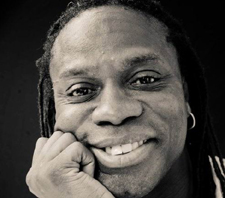
CatScratch Theatre and The Irondale Center Present the Second Annual FLICfest

By Carrie Stern
Have you heard? We’re in an economic downturn. I don’t care what the papers say about job numbers going up: Today, with grant agency funding down and rental and other costs going up, it’s harder than ever for struggling choreographers to afford to mount new work. So what to do?
A year ago choreographer Jeramy Zimmerman, in conjunction with Fort Greene’s Irondale Center, initiated FLICfest (Feature Length Independent Choreography). Zimmerman hopes this is a new model for producing and sharing original choreography. “The overwhelming response to FLICfest’s first year indicated that we were on to something great,” said Zimmerman.
Showcases are single performances that lump together works of limited length, often excerpts, by multiple choreographers. FLICfest — two weekends, six shows (two per night), 12 choreographers chosen from open submissions by a committee of five including Zimmerman — is a gathering of full-length works, one per time slot. Lowering individual production costs frees choreographers to focus on artistic exploration; funding for festival costs comes from a variety of public and private sources. Joining forces around promotion, everyone, including the festival, gains a broader audience. And, with a nightly fee (covering two shows and the cabaret) barely higher than the least expensive concert, as well as festival passes and cabaret-only admission, audiences get options and bargains.
New this year: two panel discussions. Moderated by choreographers Alexandra Beller (self-producing) and Reggie Wilson (creating feature-length dance), Zimmerman hopes to involve the wider dance community. “We decided that we needed not only to continue, but to carefully expand and grow FLICfest into an essential part of the Brooklyn performing arts viticulture.” Technique and composition classes, taught by FLICfest choreographers, round out the festival.
FLICfest choreographers epitomize a wide-range of approaches. I asked them to share something interesting about their background or work. Two major themes emerged in their responses: collaboration and influences.
Two Israeli-American choreographers influenced Robin Neveu Brown. “I dream of having works as vivid and eclectic as Neta Pulvermacher’s. Her creative process is about trusting, experimenting. I’ve tried to keep this sense of play as part of my process in ‘Pare,’” about a couple’s tumultuous relationship, created with musician-husband Kevin Brown. “Deganit Shemy taught me the value of dissecting physical details, uprooting my aesthetic notions,” and ideas of human interaction, said Neveu Brown.
Keith Thompson’s “Beginnings Forever Lost” explores the physical effects of migration and immigration set to a collage of music and text. Thompson, who danced for Trisha Brown, Bebe Miller and now Liz Lerman, says Lerman “taught me to be open to working with all abilities. I am discovering and cultivating how my process can be adapted to and generated from multi-generations. This is a new pathway in the way I think of making work. I think it makes it more accessible.”
Japanese-born Mana Kawamura’s “Pandora -deluxe-” explores the narrative of the eponymous Greek myth and the emotions behind the protagonist’s fateful curiosity. Kawamura studied for three years at Folkwang Hochschule under Pina Bausch company members Dominique Merci and Malou Airaudo. “I think Pina Baush definitely influenced me. Or living in Germany influenced me I guess. But it’s hard to say how. I met lots of choreographers, dancers and non-dancers in Germany, Japan and in New York. I am influenced by them all.”
Britany Baily’s “Goodness Management,” a work that asks what it takes to be good, is derived in part from dancing with innovative British choreographer Michael Clark. Baily felt “incredible pressure” on her creativity, “my soul,” due to Clark’s intense schedule. “I decided not to affiliate my creative process and self with contracts and time lines,” and to embrace each day anew, said Baily. Re-performing artist Marina Abramovic’s durational work and whirling with dervishes in the Middle East, she discovered stillness. “Whirling in circles, at a certain point, I experienced complete stillness inside myself while the room itself whirled around me. Performing Abramovic’s work, she discovered, “once you are still, you are still moving.”
Culture and society influenced choreographers Niles Ford and Carlos A. Cruz-Velázquez. The founder of Urban Dance Collective, a Brooklyn-based company that addresses social issues through the arts, Ford’s new work, “Summer of Hate/15 Steps,” draws on conversations around race and media, particularly technology, emerging during Barack Obama’s election. Ford, influenced by club and street dancing, Martha Graham, Catherine Dunham and West Africa, identifies with the multicultural arts movement that burgeoned in the late ’80s and ’90s. A Bessie Performance winner, Ford danced with Dance Theater of Harlem, Philadanco, Bill T. Jones, and Marlies Yearby, the choreographer of “Rent” with whom he collaborated on a tribute to Muhammad Ali, among others. They “all helped to free me artistically. Ron Brown helped me find my own voice.”
“Training in modern dance in a country where the folk tradition is strong was difficult,” Mexican choreographer and Fulbright scholar Carlos A. Cruz-Velázquez writes. “I was always curious.” Traveling with a folkloric company for 20 years, “I took class with teachers from everywhere. Being a Fulbright Fellow, I have the opportunity to discover and listen to new cultures.”
“mr. blow,” a dark comedy, is inspired by these travels, childhood and an obsession with circuses. “My background in folk dance influences the structure and musicality of my choreography, but I transform it; I take from everything.”
Many of this year’s choreographers work collaboratively. Interdisciplinary dance, theater and media artists, Adrian Jevicki and Run Shayo were surprised to find that their “creative language and methodologies meshed fairly seamlessly.” The multiple “lenses through which we view and create work allows us to interpret and play with form and structure,” Jevicki says. “Improvisation is invaluable. In rehearsal we bring in scores. Improvising within them leads to new discoveries, new scores. We could go on forever.” “The DEEP” explores fluctuations between the two-dimensionality of comic books and three dimensions — a blow-up doll is involved. “Adrian and I experiment with the dynamics of whatever is happening between us,” writes Shayo. “We are not concerned with our identities, we can be whoever we want in our own skin.”
The MerryMakers’/Lillibelle’s and Wild Red’s (Elizabeth Burwell’s and Rachel Sattler’s) “Adventures in Anytown” is a mixed-media extravaganza inspired by vaudeville. “Our collaboration starts with music, a prop, or image that inspires one of us. We brainstorm a story, experiment with movement and sequences, spend time trying to ‘sell’ our viewpoint to the other.” Highly trained dancers, “our diversity frees us to find the movement best suited to each part of the story.” We try “to create work that’s accessible to a wide audience, that makes someone laugh. We want people to have a great time and not feel they need a dance education to appreciate the work.”
The performer/director is another sort of collaboration. “Studies of Inertia,” a solo by Belgian Elke Luyten, utilizes a movement score based on the struggle of managing, and the choreographic limitations of, an imposed physical difficulty. “There is a hidden vulnerability in ferociously trying to execute a task,” writes Luyten. “We are discovering the limitations in certain dance vocabularies,” says Kira Alker, who has directed Luyten for ten years. After witnessing multiple rough drafts, Alker “strips things away, cleans up the score, and points out” Luyten’s habits of movement. “We’ve tried to be especially critical about the source of the movement — to avoid aesthetical and theatrical traps. I feel we are just starting to be really honest about the desires and the limitations we each bring to the table.”
Several create collaboratively with their companies. Erica Essner asks questions of her dancers who respond in journals. Centered on global and local cultural influences, “being present in relationships and in nature,” and the cast’s personal history, the questions underlie movement themes. Essner, acting as “movement editor,” blends conceptual elements, movement and form, merging company members’ idiosyncratic styles. “Weathered,” a highly physical work incorporating meditation and created in association with the Brooklyn Zen Center (Essner is a practitioner), “is a metaphor for the harmony and chaos of life.” It “explores slippage, displacement and resistance, delving into humanity’s loss of control over the forces of nature and how those forces belie the illusion of our permanent place on this planet.”
After 10 years in New York, Jordon Fuchs moved to Denton, Texas, where he’s an assistant professor of dance at Texas Woman’s University. “Strange Planet” is inspired by the experience of acculturation to a new home, by a pervasive undercurrent of disorientation. A contact improviser, Fuchs initially used improvisation “as a means of generating content. More and more, it’s a means of creating” in performance. “It’s been interesting figuring out how much structure is needed to support the performers. The presence, engagement and alertness of the improvising performer who directs the work and each other from within the performance is a quality I find captivating.”
Tanya Calamoneri/Company SoGoNo is inspired by Buddhism “played out through butoh. My dancing is changed by the practice of obliterating the ego, the idea that there is no longer an ‘I’ dancing. It’s not how the wind blows ‘me,’ but just the wind blowing, for example.” For “Bird Suite,” an exploration of bird-nature including anthropomorphic imaginings of a flamingo lawn ornament’s dream of Las Vegas, “we spent a fair amount of time exploring bird hatching to get the sensations in the body. I use butoh methods of erasing thinking about that quality in favor of just sensing it. That’s how I find elements of surprise in every performance, why I never completely set a performer’s actions, so there is room for the moment to shine through.”
Make sure to stay for the cabaret held in Irondale’s friendly balcony lounge. Informal, lively and full of surprises, it was the surprise hit of last year’s festival. This season cabaret guest-curators/MCs include Monstah Black and Luke Miller. Additional guest-MCs to be announced.
For FLICfest performance, panel and class schedules go to www.flicfest.org. All events take place at The Irondale Center, 85 South Oxford Street, Fort Greene. Tickets and directions at (718) 488-9233 or online at irondale.org/dance.html
Editor’s note: Dancer-choreographer Niles Ford, one of the choreographers noted in this column, passed away unexpectedly this past weekend. His company, Niles Ford/Urban Dance Collective, is scheduled to perform his Summer of Hate/15 Steps as part of FLICfest next Friday, Jan. 27 at 9 p.m. It has been reported that that program will also include a video tribute and dance party with a DJ in celebration of Niles’s life. The 9 p.m. performance is free of charge.
Leave a Comment
Leave a Comment


